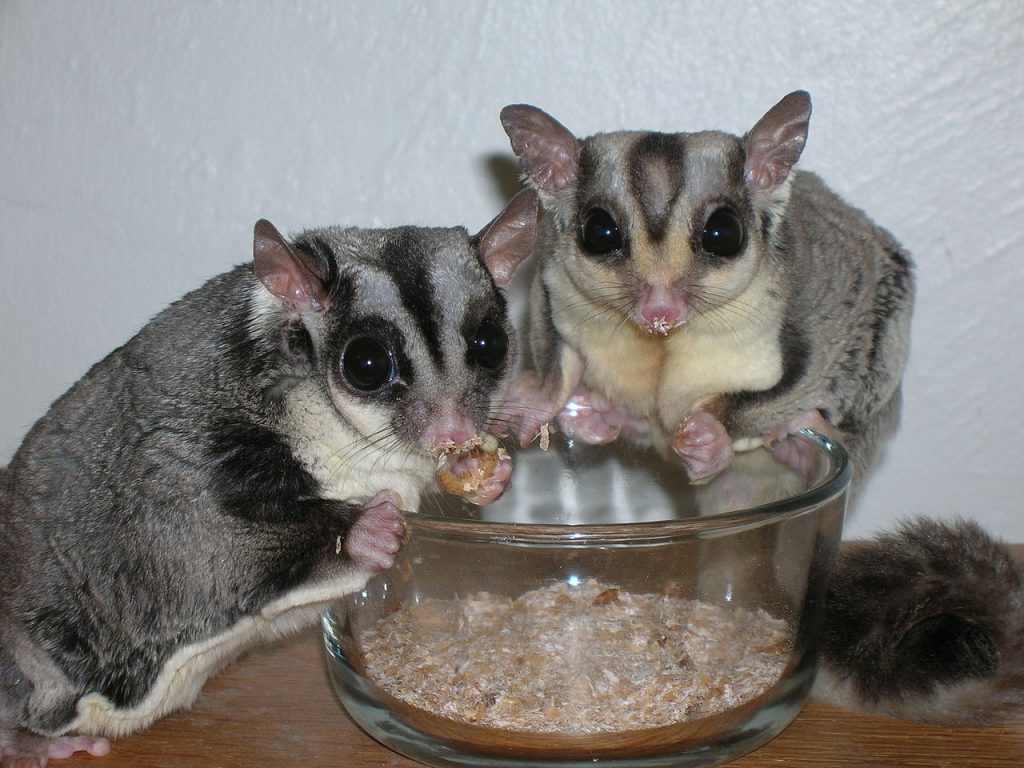You’ve seen pictures of adorable sugar gliders on the Internet or on television. Are you wondering where you could get one of these cuties?
Well, before you decide to bring one home, here’s some valuable information about sugar gliders.
What Are Sugar Gliders?
Sugar gliders, also known as Sugar Bears or Sugar Monkeys, are nocturnal, omnivorous creatures belonging to the Koala Bear or Kangaroo family. They are tiny enough to fit in your pocket and are notoriously famous for their sweet tooth.
Anything and everything containing sugar is their preferred food. Like flying squirrels, they can glide through the air, hence the name sugar gliders.
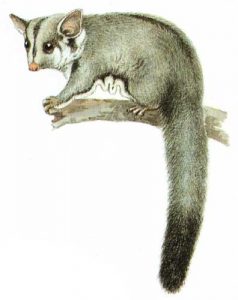
Their fur is soft with colouration ranging from pale grey to brown and fading to lighter shades on the underside of the body. A black stripe stretches all the way from its nose to its midway and then to the back. Their bellies, throats, and chests are cream.
Where Do Sugar Gliders Live
Mainland Australia, New Guinea, and some parts of Indonesia are where they originate. These delightful creatures prefer canopy environments with many stems and a dense middle and upper part allowing them to move around freely.
They usually sleep through the day in hollow parts of leafy trees and are active at night.
Sugar Glider Facts
A sugar glider’s body resembles that of a squirrel with a weak tail. They are 24 to 30cm (12-13 inches) in length with males and females weighing 140 and 115 grams respectively. They breathe 16-40 times per minute; their hearts beat 200-300 times per minute.
Male sugar gliders have four scent glands, which are found on the forehead, chest, and two para cloacal, i.e., a common opening for the intestinal, urinary, and genital tracts.
These glands are used for marking group members and territories. Bald spots on the head and chest of males are scent glands.
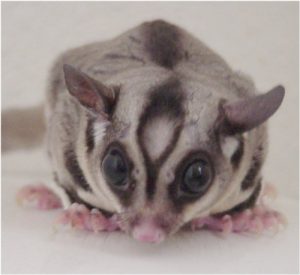
Females also have a scent gland in the common opening for the intestinal, urinary, and genital tract, as well as a scent gland in the pouch. But, they do not have glands on the head or chest. These flying mammals have large eyes that help them to see at night, and their ears swivel to find prey. Sugar gliders have four hand-like paws with opposable thumbs.
Sugar Glider Lifespan
Gliders live up to 9 years in the wild and up to 12 years in captivity. The longest reported lifespan of a sugar glider is 17.8 years. Just like other pets, diligent care and a proper diet contribute to keeping them healthy. Some warning signs to a decline in your pet’s well-being are:
- Weight or appetite loss
- Drastic changes in fur colour or consistency
- Unwillingness to eat or drink normally
- Reduced mobility, activity, or agility
- Changes in sleep patterns
Any or all these changes are a signal your furry pal needs a check-up with an exotic pet vet.
Are Sugar Gliders Good Pets
Here are five good reasons why sugar gliders are good pets:
- Sugar gliders are as intelligent as dogs are. When properly trained, they can learn their names, come when called, and even do tricks. Like dogs, sugar gliders ‘bond’ to their human families. Once accustomed to their human parents, they won’t run away. They are affectionate, playful companions and the perfect pet choice for seniors or those who live alone.
- Unlike dogs, and this is a big plus for these furry friends, they are less expensive to feed. As a rule of thumb, if you stick to a 75/25 diet supplemented by vitamins, they will stay healthy. A 75/25 diet consists of feeding them 25% fruits and vegetables and 75% quality commercial feeds.
- In addition to being cheap to feed, they don’t need any vaccinations such as rabies or distemper shots. They will not need preventative care for issues like heartworms. So, in terms of ongoing medical care, they are inexpensive and low maintenance pets.
- Curiously, they like to be carried in pockets and cuddled. Since it is popularly thought they cannot be litter trained, you might think to carry them on your person is a risky business. However, most gliders are predictable in their toileting habits, so you can set up a routine with them to avoid accidents.
- When fed a proper diet, they do not have any unpleasant odor. Also, they do not have the tendency to chew and nibble everything, which is a major plus in making them good pets. It’s their nature to keep themselves clean (just like cats). Hence, there’s no need to bathe them.
Sugar Gliders as Pets
Adoption and Price
Baby sugar gliders are called joeys. As mentioned earlier, sugar gliders bond with their owners. However, the bonding process is easier with a joey than it is with an adult.
The best age for bonding is about 8-12 weeks. While it doesn’t happen often, some sellers might misrepresent a joey’s age, so do your due diligence before making your purchase.
The wise choice is to buy these cuties from breeders with a USDA license.
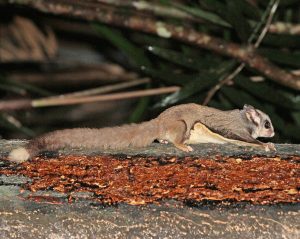
Some say sugar gliders get lonely and depressed if they do not have a companion, but that is not true. However, buying a pair is a good idea. Just as humans like to hang out with their friends, sugar gliders enjoy and benefit from social interactions.
A joey ranges in price from $200 to around $500. Older sugar gliders might cost around $100 to $150 as they are harder to train.
Baby Sugar Glider Care
Baby sugar gliders have special dietary needs. If your joey is less than six weeks old, he will still be nursing, which takes care of his nutritional needs. However, if for some reason the female is unable to nurse, the joey needs a milk replacer. Your vet can tell you where to buy the correct replacement milk and show you how to feed the joey.
Older joeys can begin eating solid foods. Offer them the same commercial feed the adults eat. Give them vegetables and fruits as treats. To prevent raising a picky eater, offer a wide variety of fruits and vegetables for your joey to try.
Legal or Illegal?
Before you get a sugar glider or any other exotic pet, it’s a good idea to do some homework. Legal exotic pet ownership in one state may be illegal in another or require you to have special licenses or permits.
Laws can vary widely from state to state and change without notice. In addition to checking state regulations, familiarize yourself with applicable local, city, or county regulations. For example, at the time of this writing, it is illegal to own sugar gliders in Alaska, Hawaii, or California. But you can own them in other states, like New Mexico if you have the proper permits.
So, where do you go to find the information you need? Your first instinct might be to use the Internet, and it can be a helpful resource.
However, if you want to make sure you’ve ticked off all the boxes to guarantee the legality of your pet, check with agencies in your area such as health departments, animal control or wildlife departments, and game control agencies.
Employees in these various agencies can usually answer your questions. If not, they can point you in the right direction for information. However, if they can’t help you, contact organizations in your area like the humane society, zoos or wildlife preserves, or veterinarians. Another great resource is the Association of Sugar Glider Veterinarians.
While you are researching the legality of a potential purchase, ask your contacts to refer you to a reliable source for buying a sugar glider.
While this may seem like a time-consuming task, and it will be, it is better than the alternative. If owning a sugar glider is illegal in your area, you could be facing legal charges, fines, or other adverse issues. Additionally, your furry friend would be taken away from you, which would surely break your heart!
Habitat and Habits
You can buy a specially made cage for your sugar glider. They love to jump, swing, and explore so include lots of branches or perches for that purpose. Toys are important for their enrichment, and you can find lots of options online.
If you buy a pair, be advised females give birth about twice a year – or more -in captivity. So, unless you want to have lots of joeys to care for, you might not want to buy a male-female pair.
Two same-sex sugar gliders cohabitate nicely. Also, if you have other pet(s), like cats or dogs, and if you’re worried they may eat these small creatures, let me assure you they won’t.
This is because sugar gliders are not rodents, so they don’t smell like food. Hence, your pet won’t know what to make of them.
They tend to jump in the water, especially toilet bowl water, which could cause them to drown. So, when you let them out of their cage for exercise, close the bathroom doors or the toilet lids.
Bonding
Plan on spending lots of time with your joeys so they can recognize your scent and voice. Once they imprint with you, then you can carry them in your pockets and enjoy their companionship 24/7. They love being in pouches, so they won’t think about leaving your pocket because it’s their comfort zone.
Diet and Hygiene
While sugar gliders do have a taste for sweets, chocolate can kill them. Yes. Chocolate is poison for your pet.
Feed your little ones fresh fruits and vegetables with a high water content, which helps keep them hydrated. Apples are a delicious treat for them.
Also, keeping a sugar glider hydrated is important to make sure fresh, clean water is always available for them.
Work with an exotic pet veterinarian to plan their diet and supplements so they get enough protein, vitamins, minerals and so forth.
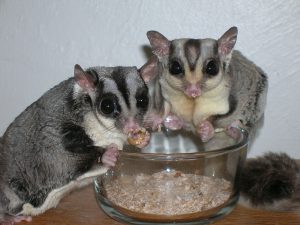
Naturally, eating leads to pooping. As mentioned earlier, sugar gliders are clean creatures and hence, they do not defecate where they sleep. You can try to train your pet to use a litter box but don’t be disappointed if it refuses to use it.
What Do Sugar Gliders Eat
While we touched on sugar glider diets in general, you might wonder what specific food items your glider will enjoy eating. One important fact is regardless of what type of food you decide to use, you must make sure your glider gets enough calcium.
Just like humans, a lack of calcium leads to brittle bones and fractures. Sugar gliders are prone to metabolic bone disease, which is caused by an imbalance of calcium and phosphorus in their diet.
That said, they enjoy protein, fruits, and vegetables. Live insects supply protein but buy them from a trusted vendor. This is because you want to know you are not feeding them insects treated with pesticides or other toxic chemicals. Zoo quality insectivores like mealworms, wax worms, spiders and so on are a safe choice. Your vet or your local zoo can help you find a reliable source.
Offer them small, chopped amounts of vegetables such as:
- Carrots
- Corn
- Lettuce
- Sweet potatoes
- Squash
- Tomatoes
Add these supplemental foods to whatever commercial feed you use as their primary food source.
Give them small treats such as chopped apples, bananas, or melons. Tropical fruits like kiwi fruit, oranges, or papaya are other good choices. Just like human kids, who tend to cherry-pick their favourite foods, it’s better to offer them a mix of different fruits so they get a good nutritional blend.
Do you know how hard it is to get your kids to eat vegetables if they have been bingeing on sweet foods like fruit? Given a choice, your sugar glider will ignore the vegetables and gobble up the fruits. To keep this from happening, offer vegetables first.
Sugar Glider Flying
While your sugar glider can’t fly like a bird, gliders can – well, glide -impressive distances. Their gliding ability is enabled by the stretchy skin flap that connects their legs. This flap, which is called the patagium, can be seen when your pet stretches out all four feet.
Sugar Glider Care
Sugar gliders aren’t susceptible to many illnesses. And if they do get sick, any vet who has experience of working with small animals should be able to treat an ailment.
So, now you know a lot about sugar gliders and can make a wise decision about adopting one or two. We hope you have a wonderful experience!
Image Source: Internet

